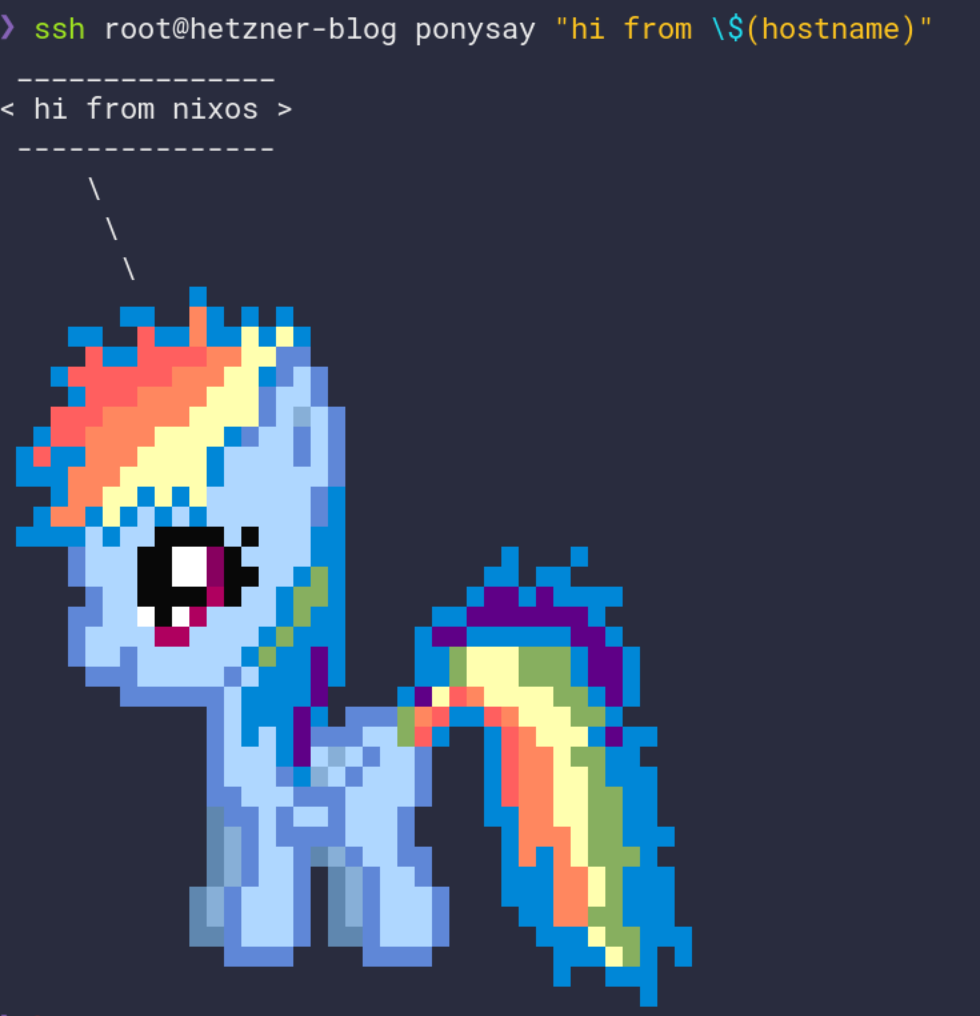Setting up tailscale Link to heading
One sad thing is that the host currently exposes SSH over the Internet. There is also a risk of accidentally exposing another service. To mitigate this risk, we can use modern VPNs and add additional firewalls on the Hetzner side.
To avoid the hassle of managing my keys, I’ll be using a generous tailscale free tier. To enable tailscale, we’ll have to add one line in our configuration:
# configuration.nix
services.tailscale.enable = true;
After switching to this configuration, we can manually over ssh configure tailscale using tailscale login to attach a new node to our tail net.
Tailscale uses persistent ips that we can check by using ip command:
[root@nixos:~/blog]# ip addr show tailscale0
3: tailscale0: <POINTOPOINT,MULTICAST,NOARP,UP,LOWER_UP> mtu 1280 qdisc fq_codel state UNKNOWN group default qlen 500
link/none
inet 100.96.101.15/32 scope global tailscale0
valid_lft forever preferred_lft forever
...
## Exposing only the intended ports
We can observe the exposed ports using `nmap`
```bash
❯ nix run nixpkgs#nmap -- -sT blog.flakm.com
PORT STATE SERVICE
22/tcp open ssh
80/tcp open http
443/tcp open https
Now we can modify hetzner firewall rule:
# Define a Hetzner Cloud Firewall
resource "hcloud_firewall" "web_firewall" {
name = "web-firewall"
# Allow TCP Port 443 (HTTPS)
rule {
direction = "in"
protocol = "tcp"
port = "443"
source_ips = ["0.0.0.0/0", "::/0"] # Allow from any IP
}
# Allow TCP Port 80 (HTTP)
rule {
direction = "in"
protocol = "tcp"
port = "80"
source_ips = ["0.0.0.0/0", "::/0"] # Allow from any IP
}
# Allow outgoing TCP to *:80 and *:443
rule {
direction = "out"
protocol = "tcp"
port = "80"
destination_ips = ["0.0.0.0/0", "::/0"]
}
rule {
direction = "out"
protocol = "tcp"
port = "443"
destination_ips = ["0.0.0.0/0", "::/0"]
}
# Allow UDP from :41641 to *:*
rule {
direction = "in"
protocol = "udp"
port = "41641"
source_ips = ["0.0.0.0/0", "::/0"]
}
# Allow UDP to *:3478
rule {
direction = "out"
protocol = "udp"
port = "3478"
destination_ips = ["0.0.0.0/0", "::/0"]
}
}
# Define a Hetzner Cloud Server resource for the blog
resource "hcloud_server" "blog" {
name = "blog-instance"
image = "ubuntu-22.04" # After provisioning, NixOS will be installed see @install
server_type = "cpx11" # AMD 2 vCPU, 2 GB RAM, 40 GB NVMe SSD
location = "fsn1"
ssh_keys = [hcloud_ssh_key.yubi.id] # SSH keys associated with the server
# 👇 Associate the firewall
firewall_ids = [hcloud_firewall.web_firewall.id]
}
And now, after fast tofu apply the ssh is no longer publicly available:
# over public internet
❯ nix run nixpkgs#nmap -- -sT blog.flakm.com
PORT STATE SERVICE
80/tcp open http
443/tcp open https
# over tailscale
❯ nix run nixpkgs#nmap -- -sT hetzner-blog
PORT STATE SERVICE
22/tcp open ssh
80/tcp open http
443/tcp open https
Even if I start some network service, it will not be accessible by accident like with sshd:
❯ ssh [email protected]
ssh: connect to host blog.flakm.com port 22: Connection refused
But the connection via ssh will still be available if we use the tailscale’s dns name:

Cute and secure pony over ssh over tailscale connection
Hardening the backend service Link to heading
Since we are using systemd under the hood, we can now change the backend service to have additional systemd settings:
systemd.services.backend = {
serviceConfig = {
Restart = "on-failure";
ExecStart = "${server}/bin/backend ${config.services.backend.posts_path}";
# dynamically allocate new user and release them when the service stops
DynamicUser = true;
# mounts an empty tmpfs read only filesystem over the the space-separated list of filesystem paths you pass it
TemporaryFileSystem = "/:ro";
# /var/lib/backend will be mounted to the service
BindPaths = "/var/lib/backend";
# ensures that directory backend exists under /var/lib and has correct ownership
StateDirectory = "backend";
# sets working directory of process to this value
WorkingDirectory = "/var/lib/backend";
# the entire file system hierarchy is mounted read-only, except for the API file system subtrees /dev, proc and /sys
ProtectSystem = "strict";
# the directories /home, /root and /run/user are made inaccessible and empty for processes invoked by this unit
ProtectHome = true;
# sets up a new file system namespace for the executed processes and mounts private /tmp and /var/tmp directories inside it
PrivateTmp = true;
# hat the service process and all its children can never gain new privileges through `execve()`
NoNewPrivileges = true;
};
environment = {
"RUST_LOG" = "INFO";
"DATABASE_PATH" = "/var/lib/backend/db.sqlite3";
};
};
You can read more about systemd features here. I was surprised by the number of knobs one can turn with systemd in this department.